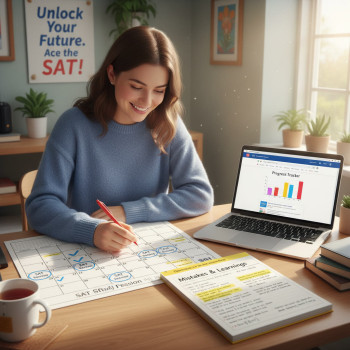Why reviewing digital SAT practice tests the right way can change everything
Take a breath. You just finished another full-length digital SAT practice test — maybe in Bluebook or another official platform — and you’re looking at a score report that tells you your section scores, a few subscores, and maybe some question-level feedback. It’s tempting to flip to the next test and keep grinding. But the real gains come from reviewing with a purpose: looking for trends, not just one-off mistakes. When you learn to review digitally produced tests like a detective, you stop repeating the same errors and start closing meaningful gaps.
The difference between practice and practice that grows your score
Everyone practices. The difference is how you review. A fast, unfocused review is like jogging in circles — you burn energy but don’t get farther. A trend-focused review is strategic; it tells you which content, timing, or question types are draining your points and where a few targeted hours can produce real improvements.
Start with the right mindset: curiosity, not punishment
Before data and charts, set the tone. Approach your results with curiosity: What does this test say about how you think? Where did my time leak? Which problems felt familiar? This positive, investigative mindset keeps you honest and helps you stick to an improvement plan instead of getting discouraged by a number on a page.
Three attitudes that help when reviewing:
- Curiosity: Ask “why” five times about each repeated error.
- Precision: Remove vague labels like “bad at math” and replace them with specific descriptors like “trouble with quadratic application problems.”
- Patience: Trends take two to six tests to become reliable. One test is a signal; multiple tests are the story.
How to collect the right digital data — what to record after each test
Digital practice platforms usually give you more granular feedback than paper tests: time per question, adaptive-section behavior, and question IDs or content descriptions. Even if the platform’s reports are limited, you can build a compact review log that over time reveals trends.
Essential items to capture after every practice test
- Raw section scores and overall score (for the digital SAT these usually include Reading & Writing and Math equivalents).
- Question-type breakdown: Command of Evidence, Heart of Algebra, Problem Solving, Data Analysis, Advanced Math, Words in Context, etc.
- Timing data: which passage or problem you spent the most time on; any timeouts or rushed sections.
- Mistake taxonomy: careless error, knowledge gap, strategy error (like skipping diagrams), or time-pressure guess.
- Emotional/context notes: Was it late? Were you hungry? Did you test in the same environment as the actual test day?
Simple template (one line per test)
- Date, test ID, total score;
- Section scores (R&W, Math); plus 3–5 most common error types;
- Top 3 weak subskills (e.g., “linear equations—application”, “passage inference”, “function notation”);
- Time trouble areas and one action (e.g., “passage 3 took 10+ min → practice active passage mapping”);
- Next practice target (e.g., “do 10 algebra application problems; review fractions”).
Build a small spreadsheet — your personal SAT dashboard
If you can open a spreadsheet, you can create a dashboard that turns a collection of test results into useful trend lines. It doesn’t need to be fancy: columns for date, test number, section scores, miscue types, time flags, and a short notes column will do. After 3–5 tests you’ll start seeing reliable patterns.
What to include in a minimal dashboard
- Date & test identifier
- Total scaled score
- Reading & Writing scaled score
- Math scaled score
- Number of careless vs. content errors
- Average time per question in each section
- One-line action item
Example table: tracking five practice tests
| Date | Test ID | Total Score | R&W | Math | Top Error Type | Avg Time/Q | Action |
|---|---|---|---|---|---|---|---|
| 2025-02-10 | Bluebook PT4 | 1180 | 600 | 580 | Algebra application | 1:25 | Practice 15 algebra problems; timed sets |
| 2025-03-05 | Bluebook PT5 | 1230 | 640 | 590 | Evidence selection | 1:20 | Do 10 paired evidence questions daily |
| 2025-04-01 | Bluebook PT6 | 1250 | 650 | 600 | Careless arithmetic | 1:10 | Slow down: check each numeric step |
| 2025-05-12 | Bluebook PT7 | 1290 | 670 | 620 | Function notation | 1:05 | Targeted function practice |
| 2025-06-20 | Bluebook PT8 | 1320 | 700 | 620 | Time pressure | 0:58 | Simulate test-day timing; sleep & nutrition |
This simple table turns scattered results into an obvious narrative: reading improved earlier, algebra lagged then got targeted practice, and time pressure became the last blocker.
How to analyze question-level trends — the meat of the review
Numbers are a start, but the biggest payoff comes from question-level analysis. For digital tests, the most useful information is not the question number but the error type and thought process that led to the wrong answer.
Three powerful question-level classifications
- Content Knowledge Error — you didn’t know how to solve the problem or recognize the method.
- Execution or Careless Error — you knew what to do but made a small mistake in arithmetic, sign, or reading.
- Strategy or Timing Error — you used an inefficient approach, ran out of time, or misread the passage structure.
Assigning each wrong answer to one of these buckets helps you prioritize. If most errors are execution mistakes, focus on disciplined checking and slower work. If many are content errors, you need targeted review and practice problems. If strategy errors dominate, practice pacing, passage-selection strategies, or efficient algebraic set-ups.
Example: Turning a set of mistakes into actions
- Fault: Missed three algebra word problems — Classification: Content Knowledge Error → Action: Relearn equation modeling and do 20 word problems with diagrams.
- Fault: Wrong answer on two simple integer arithmetic questions — Classification: Execution Error → Action: Build a checklist for every math problem: estimate, compute, sanity-check.
- Fault: Skipped a long reading passage near the end — Classification: Timing Error → Action: Practice selective passage ordering and do timed section simulations.
Seeing patterns across tests: when a trend is real
One bad test could be noise. Three or more tests showing the same weakness — especially when you use different official practice tests — is a signal you should act on. Track frequency and severity: is the error repeating across many question contexts, or only in rare formats?
Checklist to confirm a reliable trend
- Does the same error type appear in at least 3 tests?
- Does the error persist after you tried a specific correction?
- Is the error concentrated in one content area or spread across multiple areas (which suggests a skill like reading carefully)?
If you answer yes to two or more of these questions, prioritize that trend in your study schedule for the next 1–3 weeks.
Visual tools and simple metrics that reveal truth quickly
You don’t need sophisticated software. A few small visuals help a lot: a bar chart of section scores over time, a pie chart of error types, or a timeline of average time per question. Even a hand-drawn graph on a whiteboard works because patterns are easier to act on when you can see them.
Three metrics to watch weekly
- Correct rate by question type (e.g., data interpretation vs. algebra) — helps prioritize content practice.
- Average time per question vs. target time — reveals pacing problems.
- Percentage of careless errors — if this rises, slow down.
Actionable study plans from trends — how to turn insight into progress
Once trends are clear, translate them into a short, concrete study plan. The best plans are time-boxed (e.g., two weeks), measurable (do X problems, reduce careless errors by Y%), and varied (mix content review, timed sets, and full-length practice).
A sample two-week plan based on trends
- Week 1: Content focus — 30 targeted algebra application problems spread over 5 days; 20 minutes daily reviewing error explanations; one timed mini-section focused on algebra.
- Week 2: Strategy & pacing — three timed full-reading sections with forced pacing, practice selective passage ordering, and two mixed timed math sets. Take a full practice test at the end of week 2 and compare trends.
Measure success by concrete signals: improved correct rate on algebra application problems, reduced time per question without loss of accuracy, and increased confidence in passage ordering.
How to use official digital tools and reports intelligently
Platforms like Bluebook and the My Practice reports give official feedback that’s reliable and aligned with the SAT’s design. Use those reports as primary data but augment them with your own notes. For example, if Bluebook shows you missed several evidence questions, dig into whether the issue was inference, literal reading, or sentence-level understanding.
Tips for using digital reports well
- Export or screenshot question-level feedback immediately after the test while your memory is fresh.
- Match question IDs or descriptions to your spreadsheet so you can track repeats.
- When a platform shows a time spike on a specific question, replay your thought process: did you read the prompt carefully or make assumptions?

When and how to get outside help — tutors, teachers, and Sparkl’s personalized tutoring
Some trends you can fix on your own: content gaps are often resolvable with deliberate practice and targeted resources. Other issues — like deeply ingrained test-taking habits, time management under pressure, or translating knowledge into speed — can improve faster with a coach who sees patterns you can’t. That’s where targeted tutoring comes in.
How tutoring can accelerate trend-based improvement
- Expert diagnostics: a tutor can identify subtle recurring mistakes that you might rationalize away.
- One-on-one guidance: personalized sessions let you focus on exactly the subskills your tests reveal are weak.
- Tailored study plans: instead of a generic schedule, a tutor can craft a plan tied to your dashboard metrics and help you iterate it after every practice test.
For students using personalized services like Sparkl, tutors often combine human experience with AI-driven insights to speed up the cycle: quick diagnostics, bespoke practice sets, and accountability that keeps you on track. Mentioning Sparkl here because many students find the mix of expert tutors, tailored study plans, and AI-powered insights helpful — especially when trends point to complex, cross-cutting weaknesses that need consistent coaching.
Practical review workflow: step-by-step after you finish a digital practice test
Have a repeatable post-test routine and you’ll get better faster. Here’s a workflow you can implement tonight.
Post-test routine (60–90 minutes)
- Minutes 0–10: Breathe and log the basics: date, test ID, raw scores, overall feeling.
- Minutes 10–35: Do question-level classification for every wrong answer: content, execution, or strategy. Write a one-line reason for each.
- Minutes 35–50: Update your spreadsheet/dashboard and mark any repeat errors you’ve seen before.
- Minutes 50–70: Create 3–5 action items (e.g., “10 advanced algebra problems with detailed write-ups”, “timed reading section Wednesday”).
- Minutes 70–90: Do the first corrective action item (a small victory like 5 targeted problems) to start momentum.
Use comparisons and analogies to see progress — be your own control group
One convenient way to interpret improvement is to compare similar slices of tests. If you solve the same style of algebra application problems across multiple tests, track accuracy across those items. Think of each skill area as a muscle: you don’t expect an immediate jump in a week, but you should see steady gains in accuracy, speed, and confidence.
Example analogy
Improving reading for the SAT is like learning to drive a manual car: early on you stall and mis-time shifts (passage choices and pacing). After practice, your motions become smoother and you handle hill starts (dense science passages) with fewer stalls. The goal is predictable, repeatable competence.
Common pitfalls and how to avoid them
- Pitfall: Overfitting to one practice test. Fix: Use at least three different official tests before changing major strategies.
- Pitfall: Ignoring response explanations. Fix: Read the short explanation for each wrong answer and rewrite it in your own words.
- Pitfall: Treating low-level speed as the problem when the real issue is comprehension. Fix: Do untimed accuracy work before demanding speed.
When to simulate full test-day conditions
Simulations are essential. Once a week in the last month before your target test date, do a full digital practice test under realistic conditions: device set up like test day, scheduled break timing, eat the same pre-test meal, and follow the same wakeup schedule. These rehearsals help convert your trend-driven improvements into test-day performance.
Checklist for a realistic simulation
- Bluebook app set up and tested on the same device
- Same timing and break patterns as the actual test
- Minimized distractions (phone on airplane mode; household members informed)
- Post-test review within 48 hours to capture trends

How to know when your trend-analysis worked
Success looks like multiple small signals adding up: a rising correct rate in weak question types, fewer careless errors, improved average time per question, and higher scores across tests. More importantly, you’ll feel more confident and less reactive when you encounter a tricky problem on a real test.
Concrete success signals
- Three tests in a row with a rising section score in the flagged area.
- Reduced proportion of careless errors by at least 50% after a two-week checklist intervention.
- Ability to finish sections with 5–10 minutes to spare while maintaining accuracy.
Putting it all together: a sustainable, trend-driven study cycle
Here’s a repeatable cycle that turns data into improvement:
- Take one full digital practice test every 7–14 days.
- Use the 60–90 minute post-test routine above to extract trends.
- Update your dashboard and set a two-week micro-plan addressing the top trend.
- Use targeted practice, untimed accuracy work, and paced simulations as needed.
- Consider tutor support (like Sparkl’s tailored tutoring and AI-backed insights) if trends persist or plateau.
Final thoughts: trends are your compass — not a verdict
Scores are snapshots; trends are maps. When you learn to read trends from digital practice tests, every mistake becomes useful information and every test contributes to a clearer path forward. Keep notes, be honest about causes, and prioritize actions that move the needle. And remember: thoughtful review backed by targeted practice is far more productive than endless, unfocused test-taking.
If you want, start tonight: open your last digital practice report, write one precise trend you see, and plan a two-week action that addresses it. Small, consistent choices are what add up to big score gains.
Need help turning trends into a plan?
Many students find that a conversation with a tutor helps translate dashboard trends into daily habits. If you want guided one-on-one support — tailored study plans, expert tutors, and smart, data-driven feedback — consider testing a short coaching cycle. A focused coach can accelerate the process and keep you accountable to the improvements your dashboard points to.
Good luck — you’re closer than you think. Keep the curiosity, track the trends, and let each practice test teach you one new thing.

















No Comments
Leave a comment Cancel